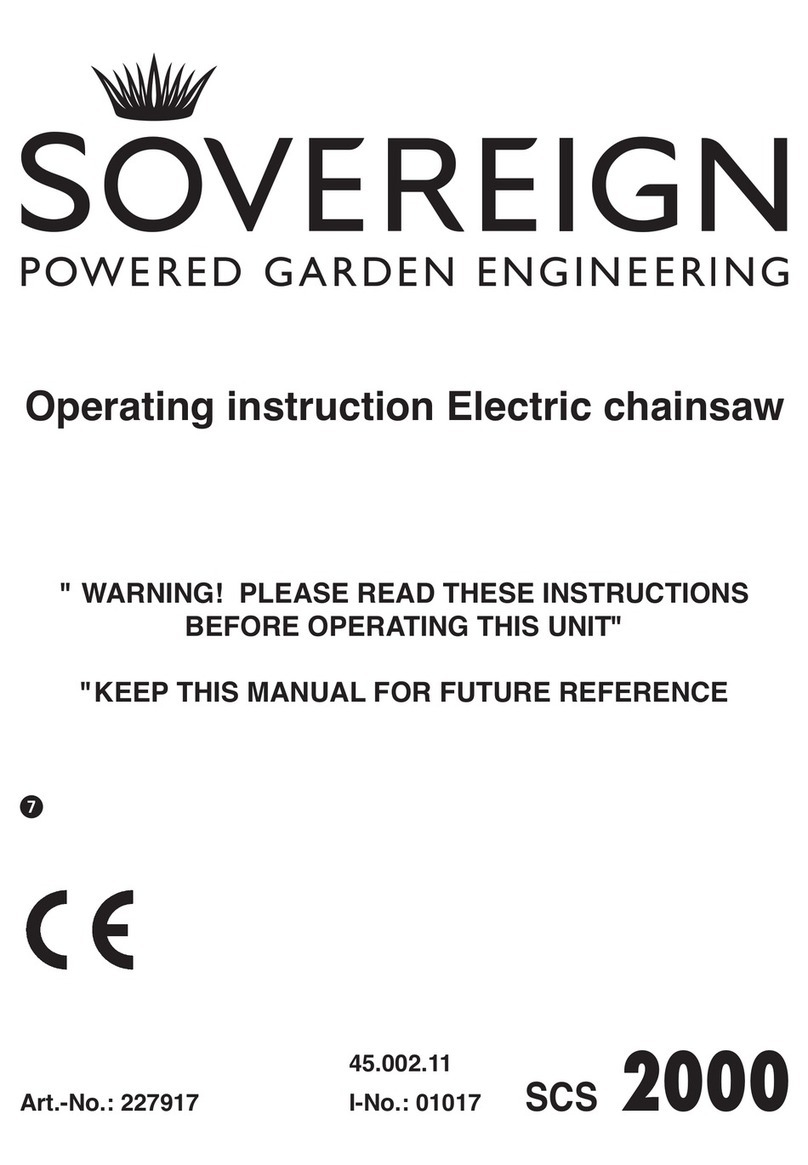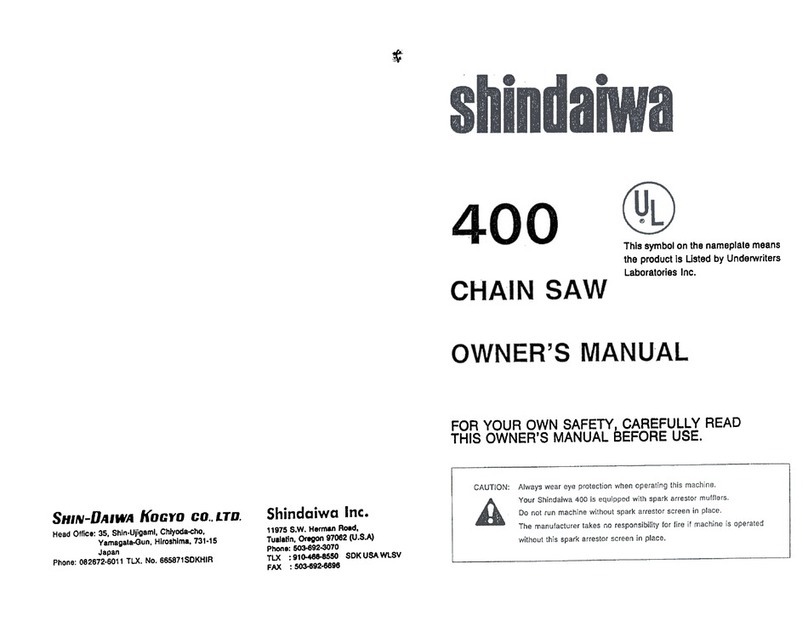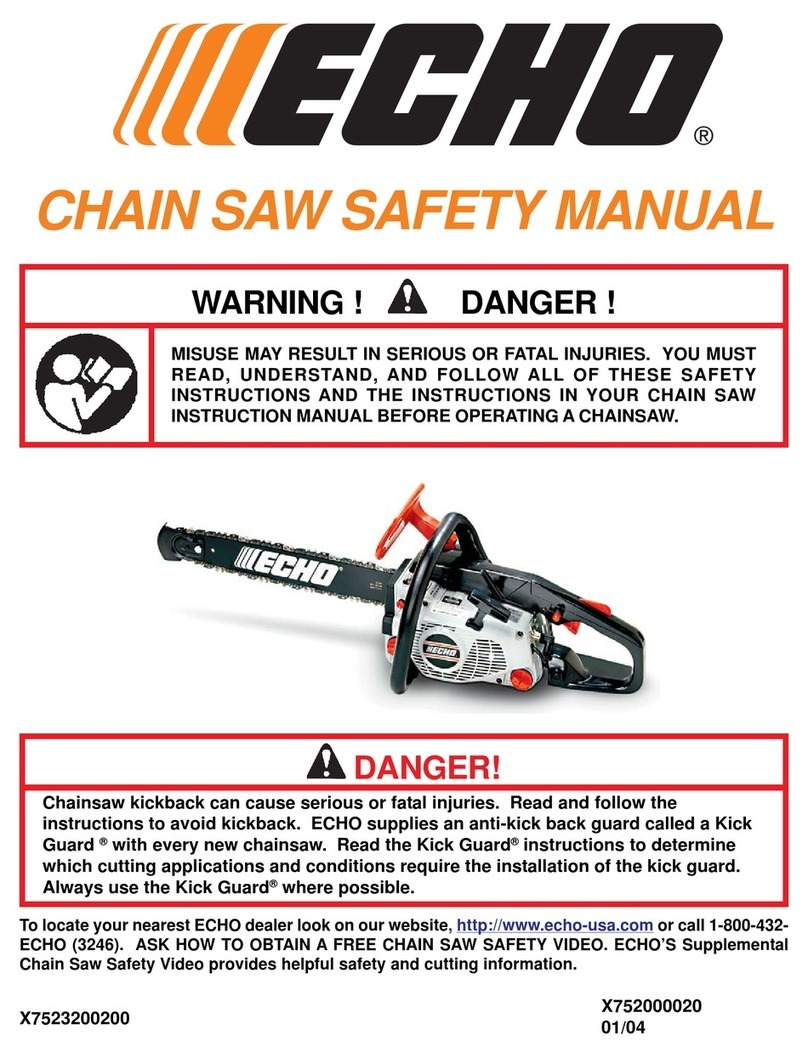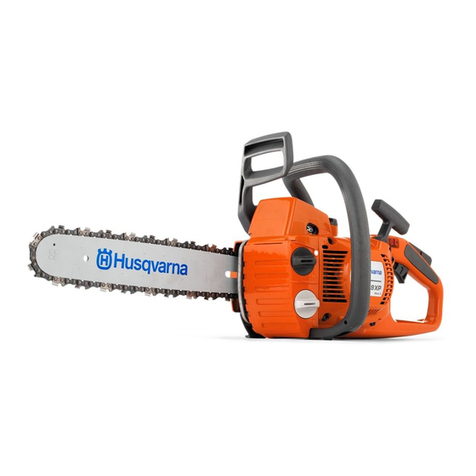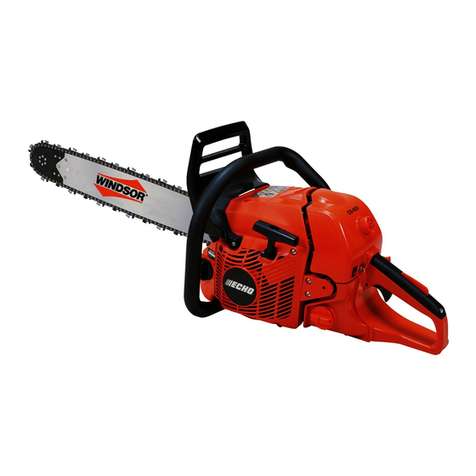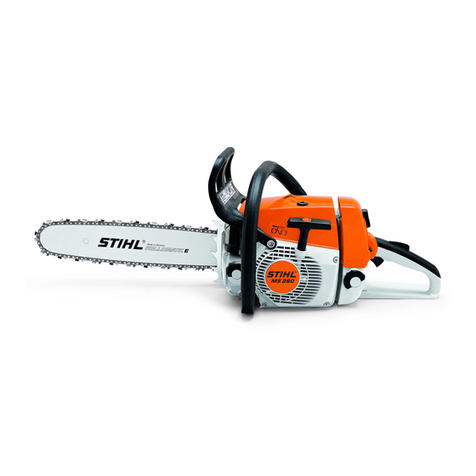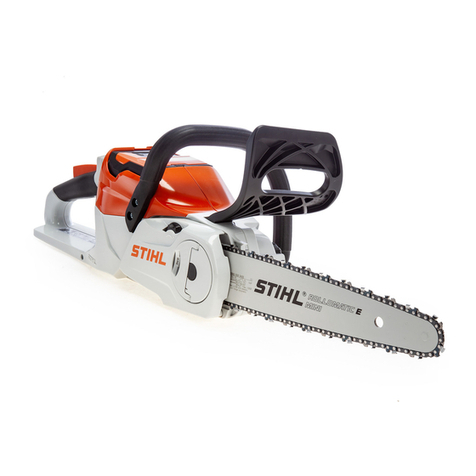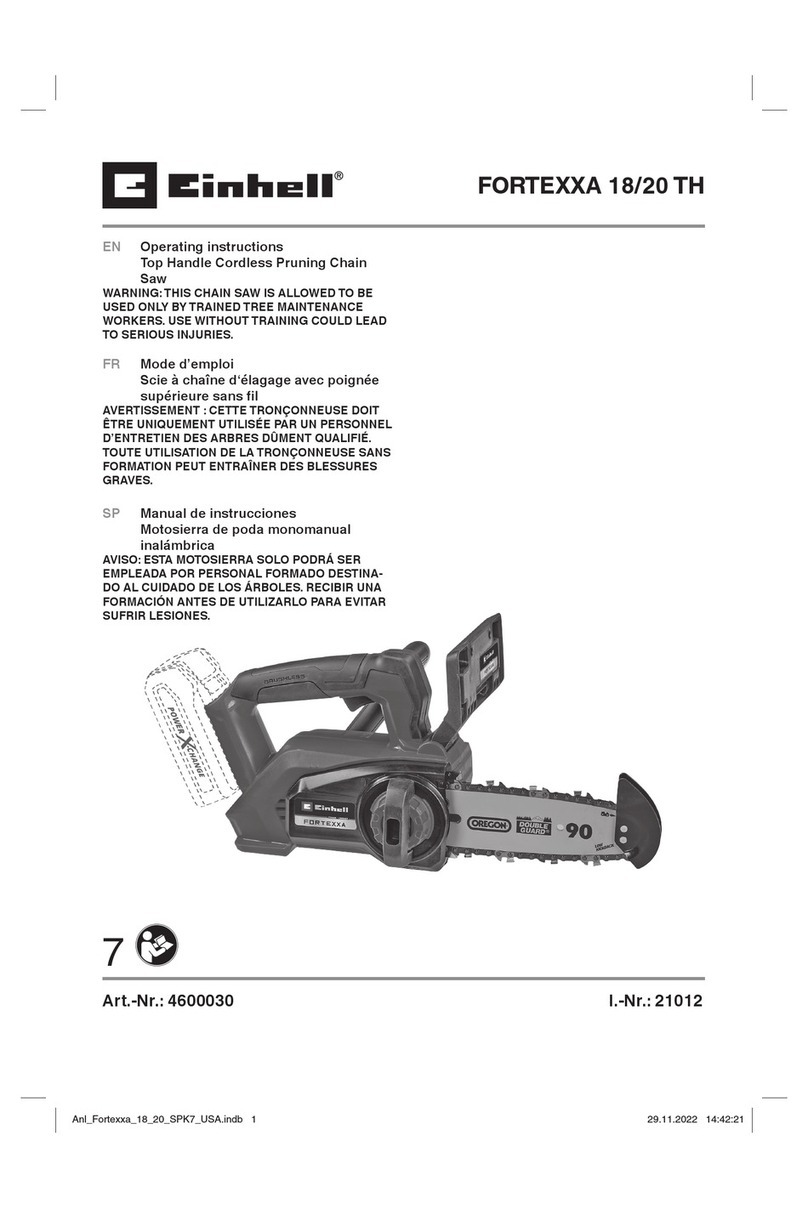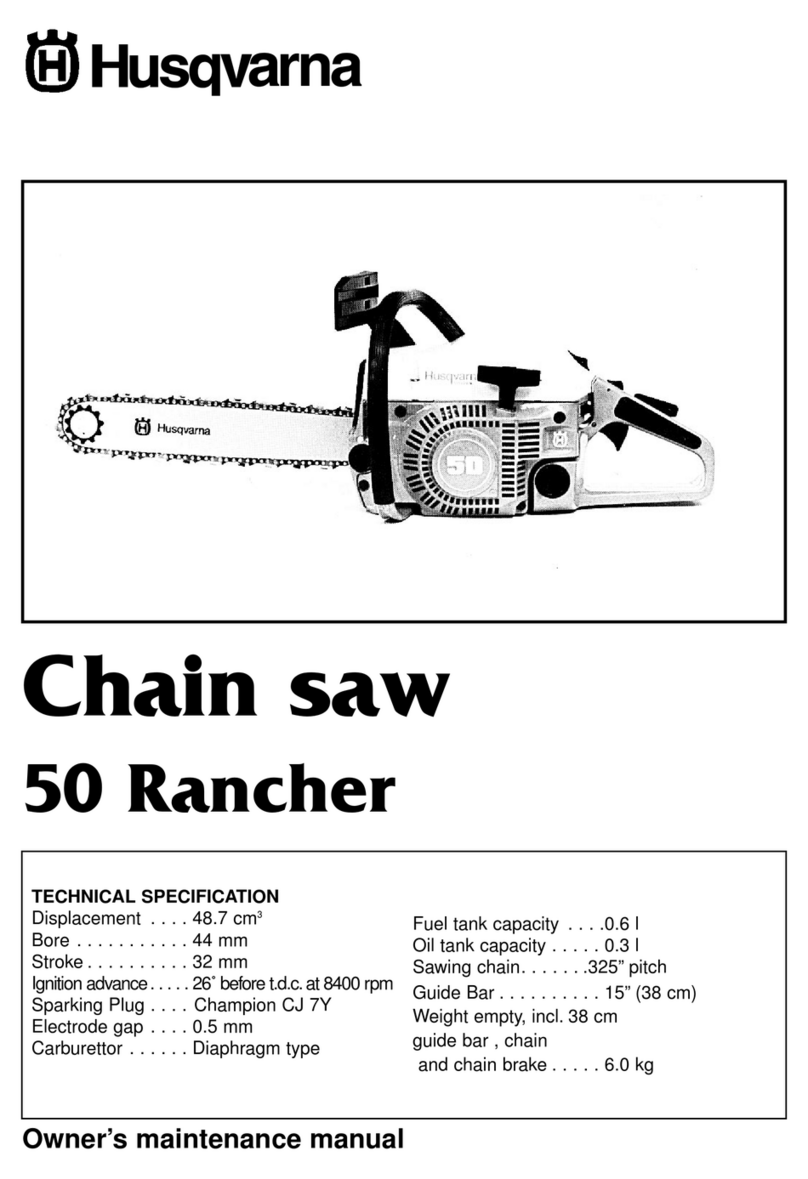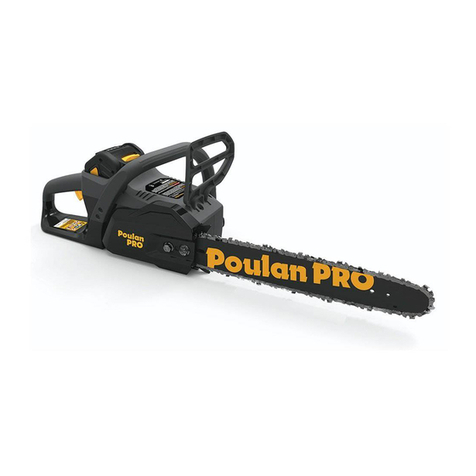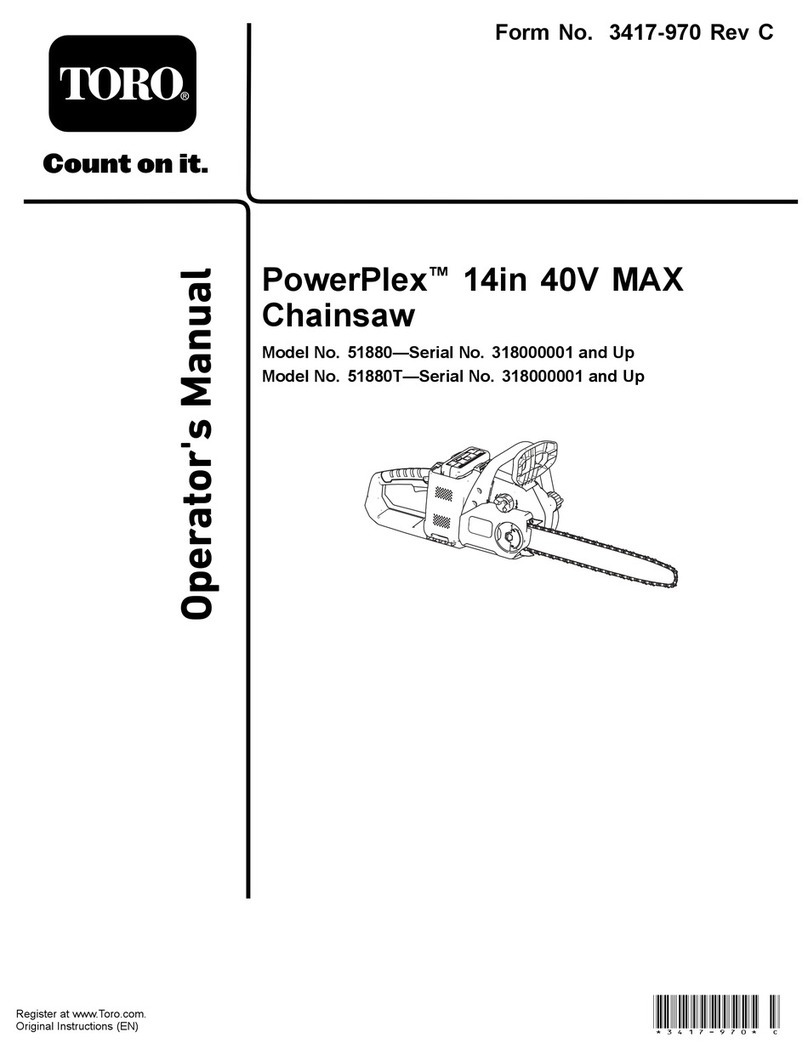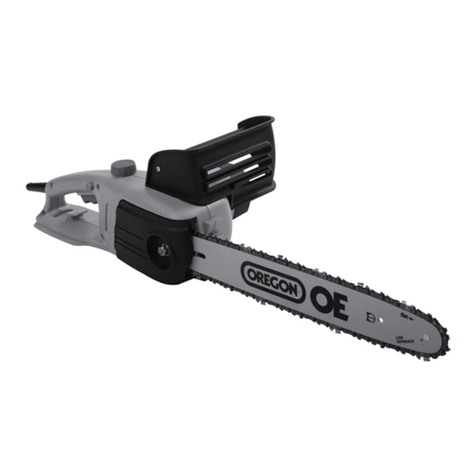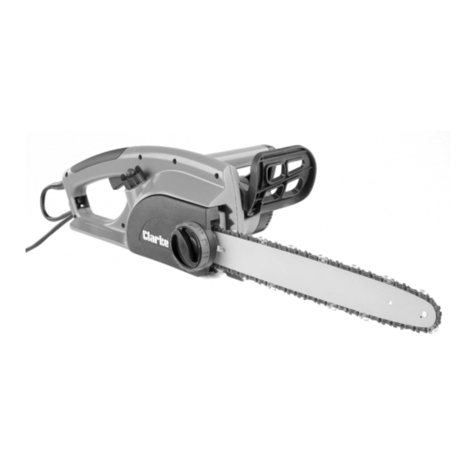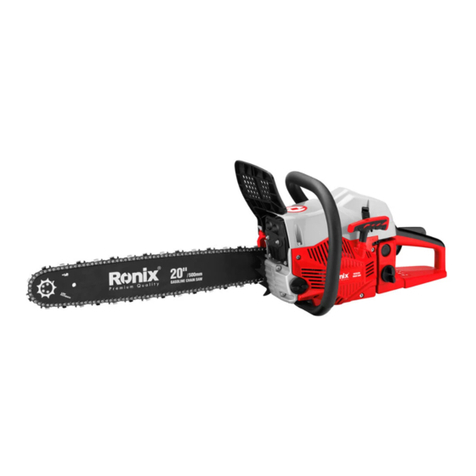Sovereign A011022 User guide

1800W CHAINSAW
ORIGINAL INSTRUCTION MANUAL
Item No. 577187
Model No. A011022
Please read these instructions fully before starting assembly.
HHGL Limited, MK9 1BA. HHGL (ROI) Limited, D02 X576 Sept. 20

2
CONTENTS
General power tool safety warnings 3
Special safety instructions for chainsaw 7
Symbols 15
Parts list 18
Intended use 19
Assembly 20
Operation 24
Cleaning and maintenance 38
Plug replacement 47
Technical data 48
Troubleshooting 49
Warranty 50
Recycling and disposal 50

3
GENERAL POWER TOOL SAFETY
WARNINGS
WARNING! Read all safety warnings
and all instructions. Failure to follow the
warnings and instructions may result in
electric shock, fire and/or serious injury.
Save all warnings and instructions for
future reference. The term ‘power tool’ in
the warnings refers to your mains-operated
(corded) power tool or battery-operated
(cordless) power tool.
Work Area Safety
a) Keep work area clean and well lit. Cluttered or
dark areas invite accidents.
b) Do not operate power tools in explosive
atmospheres, such as in the presence of
flammable liquids, gases or dust. Power tools
create sparks which may ignite the dust or fumes.
c) Keep children and bystanders away while
operating a power tool. Distractions can cause
you to lose control.
Electrical Safety
a) Power tool plugs must match the socket.
Never modify the plug in any way. Do not use
any adapter plugs with earthed (grounded)
power tools. Unmodified plugs and matching
sockets will reduce the risk of electric shock.

4
b) Avoid body contact with earthed or grounded
surfaces, such as pipes, radiators, ranges
and refrigerators. There is an increased risk
of electric shock if your body is earthed or
grounded.
c) Do not expose power tools to rain or wet
conditions. Water entering a power tool will
increase the risk of electric shock.
d) Do not abuse the cord. Never use the cord for
carrying, pulling or unplugging the power tool.
Keep cord away from heat, oil, sharp edges
or moving parts. Damaged or entangled cords
increase the risk of electric shock.
e) When operating a power tool outdoors, use an
extension cord suitable for outdoor use. Use
of a cord suitable for outdoor use reduces the
risk of electric shock.
f) If operating a power tool in a damp location
is unavoidable, use a residual current device
(RCD) protected supply. Use of an RCD reduces
the risk of electric shock.
Personal Safety
a) Stay alert, watch what you are doing and
use common sense when operating a power
tool. Do not use a power tool while you are
tired or under the influence of drugs, alcohol
or medication. A moment of inattention while
operating power tools may result in serious
personal injury.

5
b) Use personal protective equipment (PPE).
Always wear eye protection. Protective
equipment, such as a dust mask, non-skid safety
shoes, hard hat, or hearing protection used for
appropriate conditions will reduce personal
injuries.
c) Prevent unintentional starting. Ensure
the switch is in the 'OFF' position before
connecting to a power source and/or battery
pack, picking up or carrying the tool. Carrying
power tools with your finger on the switch or
energising power tools that have the switch on
invites accidents.
d) Remove any adjusting key or wrench before
turning the power tool on. A wrench or a key
left attached to a rotating part of the power tool
may result in personal injury.
e) Do not overreach. Keep proper footing and
balance at all times. This enables better control
of the power tool in unexpected situations.
f) Dress properly. Do not wear loose clothing
or jewellery. Keep your hair, clothing and
gloves away from moving parts. Loose clothes,
jewellery or long hair can be caught in moving
parts.
g) If devices are provided for the connection
of dust extraction and collection facilities,
ensure these are connected and properly
used. Use of dust collection can reduce dust-
related hazards.

6
Power Tool Use and Care
a) Do not force the power tool. Use the correct
power tool for your application. The correct
power tool will do the job better and safer at the
rate for which it was designed.
b) Do not use the power tool if the switch does
not turn it on and off. Any power tool that
cannot be controlled with the switch is dangerous
and must be repaired.
c) Disconnect the plug from the power source
and/or the battery pack from the power tool
before making any adjustments, changing
accessories, or storing power tools. Such
preventive safety measures reduce the risk of
starting the power tool accidentally.
d) Store idle power tools out of the reach of
children and do not allow persons unfamiliar
with the power tool or these instructions
to operate the power tool. Power tools are
dangerous in the hands of untrained users.
e) Maintain power tools. Check for misalignment
or binding of moving parts, breakage of parts
and any other condition that may affect the
power tools operation. If damaged, have the
power tool repaired before use. Many accidents
are caused by poorly maintained power tools.
f) Keep cutting tools sharp and clean. Properly
maintained cutting tools with sharp cutting edges
are less likely to bind and are easier to control.

7
g) Use the power tool, accessories and tool bits,
etc., in accordance with these instructions,
taking into account the working conditions
and the work to be performed. Use of the
power tool for operations different from those
intended could result in a hazardous situation.
Service
Have your power tool serviced by a qualified
repair person using only identical replacement
parts. This will ensure that the safety of the power
tool is maintained.
WARNING! This machine produces
an electromagnetic field during
operation. This field may, under some
circumstances, interfere with active
or passive medical implants. To reduce
the risk of serious or fatal injury, we
recommend persons with medical
implants consult their physician and the
medical implant manufacturer before
operating this machine.
SPECIAL SAFETY INSTRUCTIONS FOR
CHAINSAW
· Keep all parts of the body away from the saw
chain when the chainsaw is operating. Before
you start the chainsaw, make sure the saw

8
chain is not contacting anything. A moment of
inattention while operating chainsaws may cause
entanglement of your clothing or body with the
saw chain.
· Always hold the chainsaw with your right
hand on the rear handle and your left hand on
the front handle. Holding the chainsaw with a
reversed hand configuration increases the risk of
personal injury and should never be done.
· Wear safety glasses and hearing protection.
Further protective equipment for head, hands,
legs and feet is recommended. Adequate
protective clothing will reduce personal injury by
flying debris or accidental contact with the saw
chain.
· Do not operate a chainsaw in a tree. Operation
of a chainsaw while up in a tree may result in
personal injury.
· Always keep proper footing and operate the
chainsaw only when standing on a fixed,
secure and level surface. Slippery or unstable
surfaces, such as ladders, may cause a loss of
balance or control of the chainsaw.
· When cutting a limb that is under tension
be alert for spring back. When the tension in
the wood fibres is released, the spring-loaded
limb may strike the operator and/or throw the
chainsaw out of control.
· Use extreme caution when cutting brush and
saplings. The slender material may catch the saw

9
chain and be whipped towards you or pull you off
balance.
· Carry the chainsaw by the front handle with
the chainsaw switched off and away from
your body. When transporting or storing the
chainsaw, please always fit the guide bar
cover. Proper handling of the chainsaw will
reduce the likelihood of accidental contact with
the moving saw chain.
· Follow instructions for lubricating, chain
tensioning and changing accessories.
Improperly tensioned or lubricated chains may
either break or increase the chance for kickback.
· Keep handles dry, clean, and free from oil and
grease. Greasy, oily handles are slippery, causing
loss of control.
· Cut wood only. Do not use a chainsaw for
purposes not intended. For example: do not
use a chainsaw for cutting plastic, masonry
or non-wood building materials. Use of the
chainsaw for operations different than intended
could result in a hazardous situation.
Causes and Operator Prevention of Kickback
Kickback may occur when the nose or tip of the
guide bar touches an object, or when the wood
closes in and pinches the saw chain in the cut.
Tip contact in some cases may cause a sudden
reverse reaction, kicking the guide bar up and back
towards the operator.

10
Pinching the saw chain along the top of the guide
bar may push the guide bar rapidly back towards
the operator.
Either of these reactions may cause you to lose
control of the saw, which could result in serious
personal injury. Do not rely exclusively upon the
safety devices built into your saw. As a chainsaw
user, you should take several steps to keep your
cutting jobs free from accident or injury.
Kickback is the result of tool misuse and/or incorrect
operating procedures or conditions and can be
avoided by taking proper precautions, as given
below:
· Maintain a firm grip, with thumbs and fingers
encircling the chainsaw handles, with both
hands on the saw and position your body and
arm to allow you to resist kickback forces.
Kickback forces can be controlled by the operator
if proper precautions are taken. Do not let go of
the chainsaw.
· Do not overreach and do not cut above
shoulder height. This helps prevent unintended

11
tip contact and enables better control of the
chainsaw in unexpected situations.
· Only use replacement bars and chains
specified by the manufacturer. Incorrect
replacement bars and chains may cause chain
breakage and/or kickback.
· Follow the manufacturer’s sharpening and
maintenance instructions for the saw chain.
Decreasing the depth gauge height can lead to
increased kickback.
Recommended:
· Use a residual current device with a tripping
current of 30mA or less.
· During the cutting operation, the supply cord
must be securely positioned to prevent the cord
from snagging on branches and the like.
· The first-time user should, as a minimum practice,
cut logs on a saw-horse or cradle.
· The chain is automatically lubricated.
· Use only new chain oil specifically formulated for
chainsaws.
WARNING! Never use wasted oil, low
quality oil, or insufficient oil. This could
damage the pump, the bar and the chain,
and may result in serious personal injury.

12
· Check the oil level before each work session, refill
if less than full. If the lubrication system does not
work properly, check if the oil filter and all oil-
ways are clean and free from obstructions. If it
is still not working, contact an authorised service
centre.
Safety Chain Brake
Kickback is a phenomenon whereby the tip of
the saw flies quickly and uncontrollably upwards
towards the operator. It happens with little or no
warning and can be caused by cutting with the blade
tip, if the saw gets pinched in its cut, or if the saw
contacts debris.
The risk of kickback can never be completely
eliminated but it can be reduced by:
· Ensuring the work area is free of debris.
· Not allowing the chain to get pinched.
· Not cutting with the danger area at the tip of the
saw (see illustration below).
Intended Use/Not intended Use
This chainsaw is only designed for cutting hedges,
trunks or timber beams up to a diameter according
to the guide bar length.
It is only allowed to cut wood. Every other use of the

13
machine is a not intended use.
Furthermore, professional use for tree services is
strictly forbidden.
During the use of the chainsaw, the user has to
arrange for personal protective equipment according
to the manual and also to the named pictograms
on the chainsaw. Parts of the intended use are also
detailed in the manual regarding safety warnings
and references for use/maintenance. People/users
who work with the chainsaw or maintain it must
be familiar with the manual. It is only permitted to
replace on the chainsaw the manufacturer’s original
or approved spare parts (guide bar, saw chain, spark
plug, e.g.) as well as the allowed combinations of
guide bar/saw chain as named in the manual.
The user and not the manufacturer is liable for
every accident which results from a combination
of not intended use or a not allowed change of the
construction on the machine.
The chainsaw is only intended to be used outdoors.
Intended Use/Not intended Use
Even with the intended use of the appliance there
is always a residual risk, which can not prevented.
According to the type and construction of the
appliance the following potential hazards might
apply:
- Contact with exposed saw teeth of the saw chain
(cutting hazards)
- Access to the rotating saw chain (cutting hazards)

14
- Unforeseen, abrupt movement of the guide bar
(cutting hazards)
- Flung out of parts from the saw chain (Cutting/
injection hazards)
- Flung out of parts of the work piece
- Inhalation of work piece particles
- Skin contact with the oil
- Loss of hearing, if no required ear protection is
used during work.

15
SYMBOLS
IMPORTANT: Some of the following symbols may be used on
your tool. Be sure to study them and learn their meaning.
Proper interpretation of these symbols will allow you to
use the machine more effectively and reduce the risk of an
accident.
Indicates danger, warning or caution.
WARNING – To reduce the risk of injury, user must read this
instruction manual.
Wear ear protection, eye protection and helmet (PPE).
Wear gloves and safety boots to protect against electric
shock.

16
Protect the machine from the damp and never expose it to
rain.
SWITCH OFF: Remove the plug from the mains before
cleaning or maintenance.
SWITCH OFF: Remove the plug from the mains immediately if
the cable is damaged or cut.
Make sure the ‘chain brake’ is disengaged.
Keep children at a distance of not less than 10m from the
work area.
Conforms to relevant safety standards.

17
This product is a class II tool.
Recycle unwanted materials instead of disposing of them as
household waste. All tools, hoses and packaging should be
sorted, taken to the local recycling centre and disposed of in
an environmentally safe way.
111
Guaranteed sound power level (tested according to Directive
2000/14/EC, as amended by 2005/88/EC).

18
PARTS LIST
1 Front handle 12 On/off switch
2 Front guard/chain brake 13 Lock-off button
3 Saw chain 14 Rear handle
4 Guide bar 15 Power cord with plug
5 Retaining nut 16 Cable strain relief
6 End cover 17 Air vents
7 Spike bumper 18 Oil level window
8 Tensioning screw for chain
tension
19 Oil tank cap
9 Bolt 20 Guide bar cover
10 Oiling port 21 Spanner
11 Drive sprocket
4 21 203
13 15
2
1912
14
1
5
17 16
6
7
8
10
91118

19
INTENDED USE
This chainsaw is designated with a rated output of 1800
Watts. The product is intended for cutting logs with a
thickness of 32.6cm max. It must not be used for cutting
other materials, such as plastics, stone, metal or wood that
contain foreign objects.
The product may only be used with the guide bar/saw chain
combination stated in these instructions. It is not permitted
to use other types or sizes.
Vertical and horizontal cuts can be performed with
this product. Longitudinal sections can only be cut by
professionals.
This product should not be used outside of domestic
premises, e.g. for cutting firewood in forested areas. The
product should not be used on masonry and material that
are harmful to health.
This product is intended for private domestic use only, not
for any commercial trade use. It must not be used for any
purposes other than those described.
Unpacking
1. Unpack all parts and lay them on a flat, stable surface.
2. Remove all packing materials and shipping devices if
applicable.
3. Make sure the delivery contents are complete and free
of any damage. If you find that parts are missing or show
damage, do not use the product but contact your store.
Using an incomplete or damaged product represents a
hazard to people and property.
4. Ensure that you have all the accessories and tools needed
for assembly and operation. This also includes suitable
personal protective equipment (PPE).

20
ASSEMBLY
Chain Tensioning Check
WARNING! Unplug the product from the power
source before adjusting the saw chain tension! The
cutting edges of the saw chain are sharp. Always
wear protective gloves when handling the chain.
NOTE: The chain and bar have already been assembled on
the machine when you get it out of box. If disassembling the
chain and bar for replacement, please read the maintenance
part in this manual for details.
Always maintain proper chain tension. A loose chain
increases the risk of kickback! A loose chain may jump out
of the guide bar groove. This may injure the operator and
damage the chain. A loose chain will cause rapid wear to the
chain, guide bar and sprocket.
Tensioning the chain too tightly will overload the motor and
cause damage; insufficient tension can cause chain derailing,
whereas a correctly tightened chain provides the best cutting
characteristics and prolonged working life. The chain life
mainly depends upon sufficient lubrication and correct
tensioning.
Check the chain tension using one hand to lift the saw chain
(3) against the weight of the product. The correct chain
tension is achieved when the saw chain can be lifted by
approximately 2-4mm from the guide bar (4) in the centre
(Figs. 1, 2).
Fig. 1 Fig. 2
This manual suits for next models
1
Table of contents
Other Sovereign Chainsaw manuals

Sovereign
Sovereign CS4100A-5 User manual
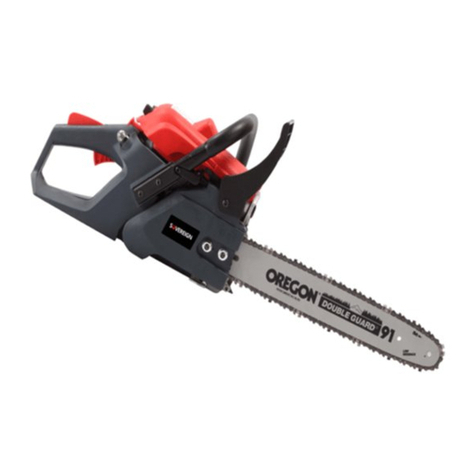
Sovereign
Sovereign PCS38Z Operation instructions
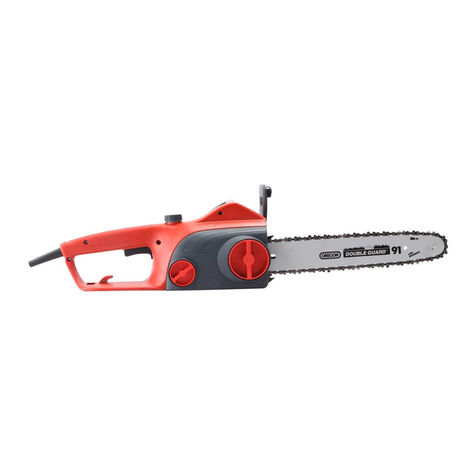
Sovereign
Sovereign SCS718A User manual

Sovereign
Sovereign SCS 38/45 User manual
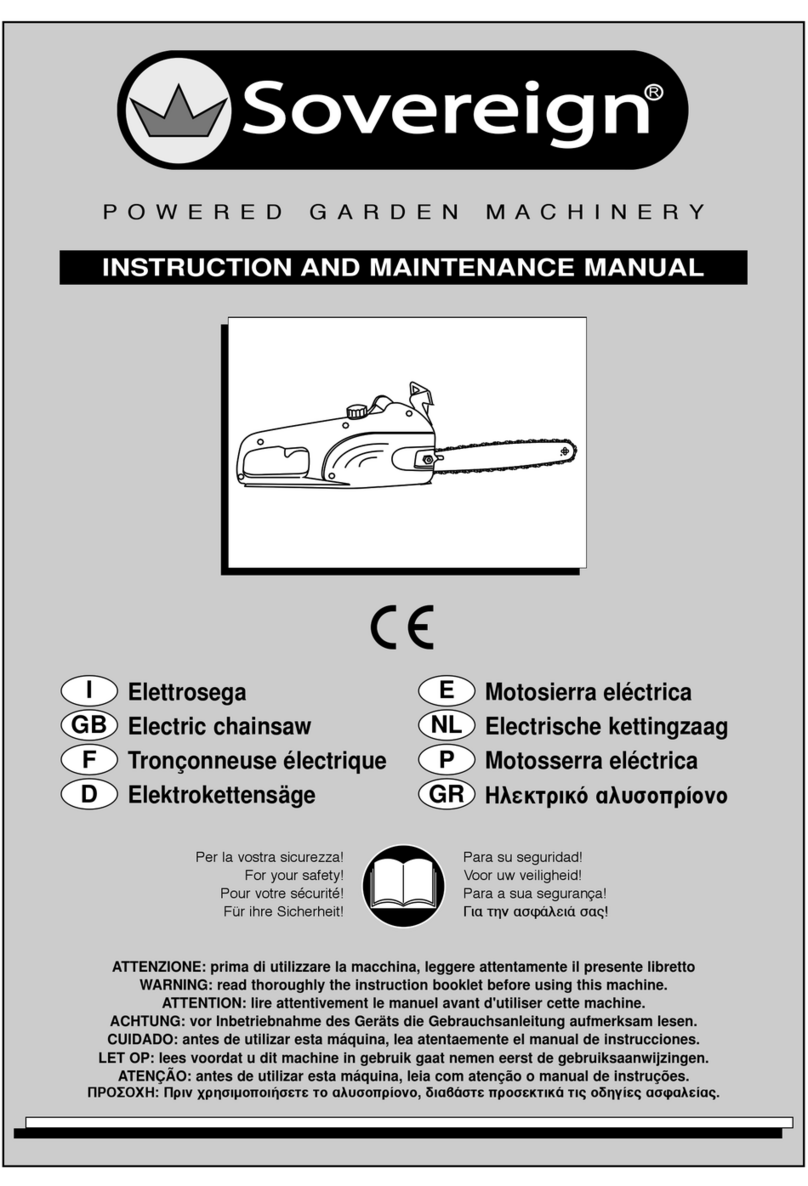
Sovereign
Sovereign Electric chainsaw Instructions for use

Sovereign
Sovereign 37 cc User manual
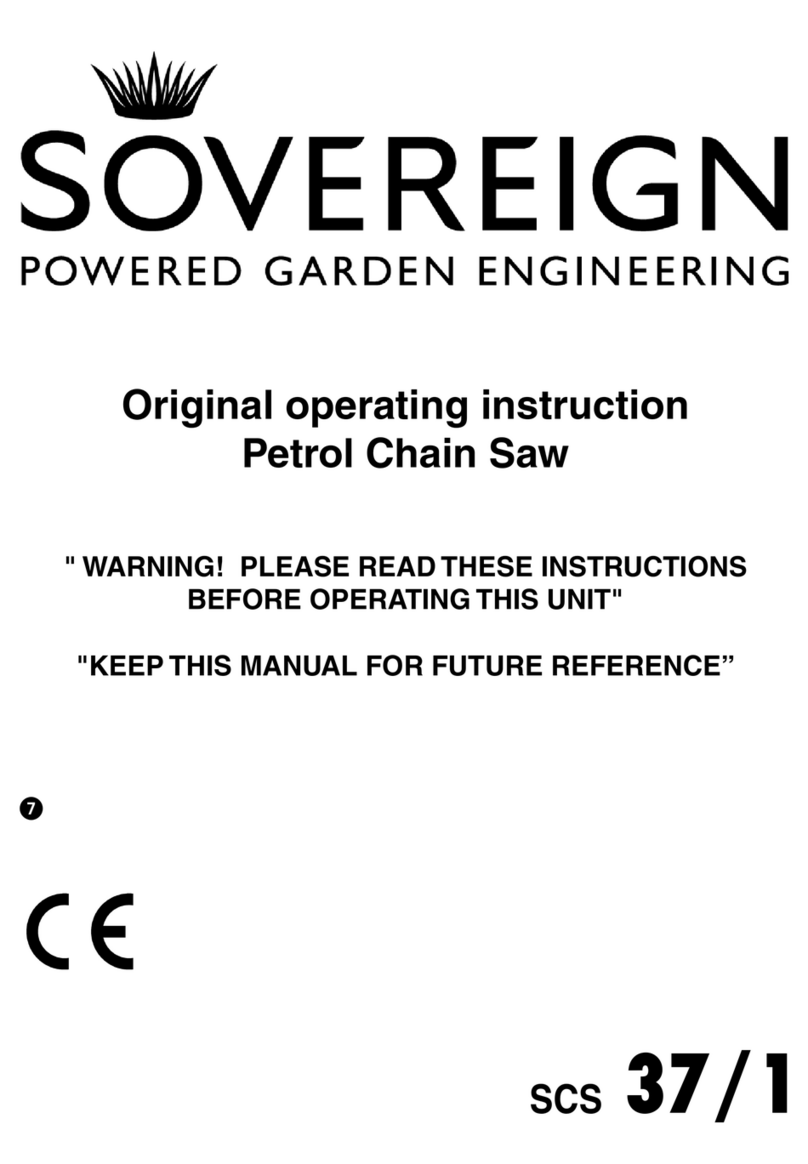
Sovereign
Sovereign SCS 37/1 User manual
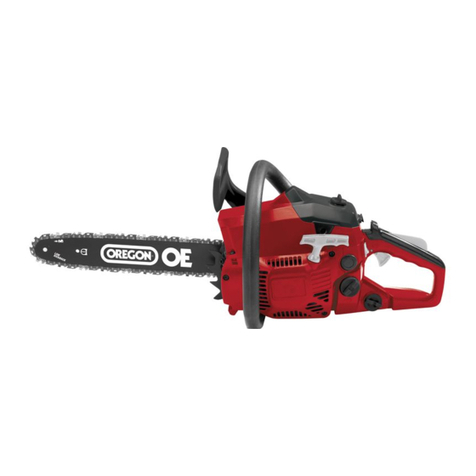
Sovereign
Sovereign SCS 37/1 User manual
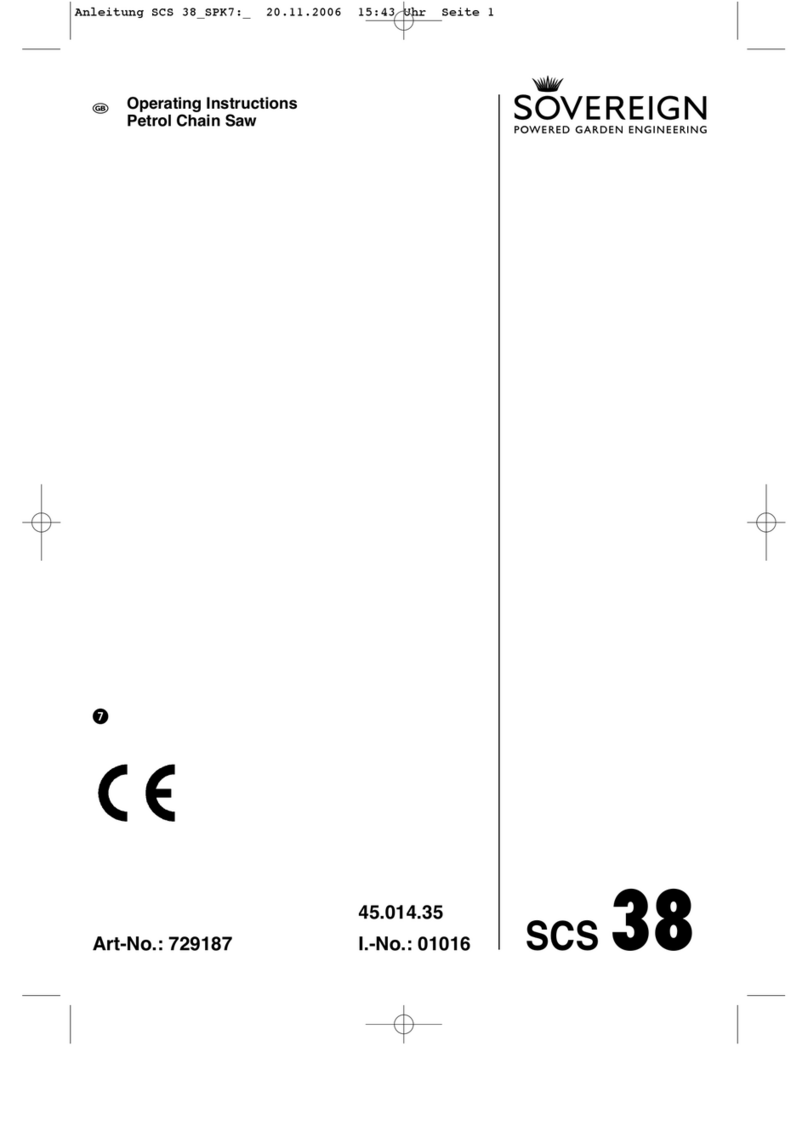
Sovereign
Sovereign SCS 38 User manual
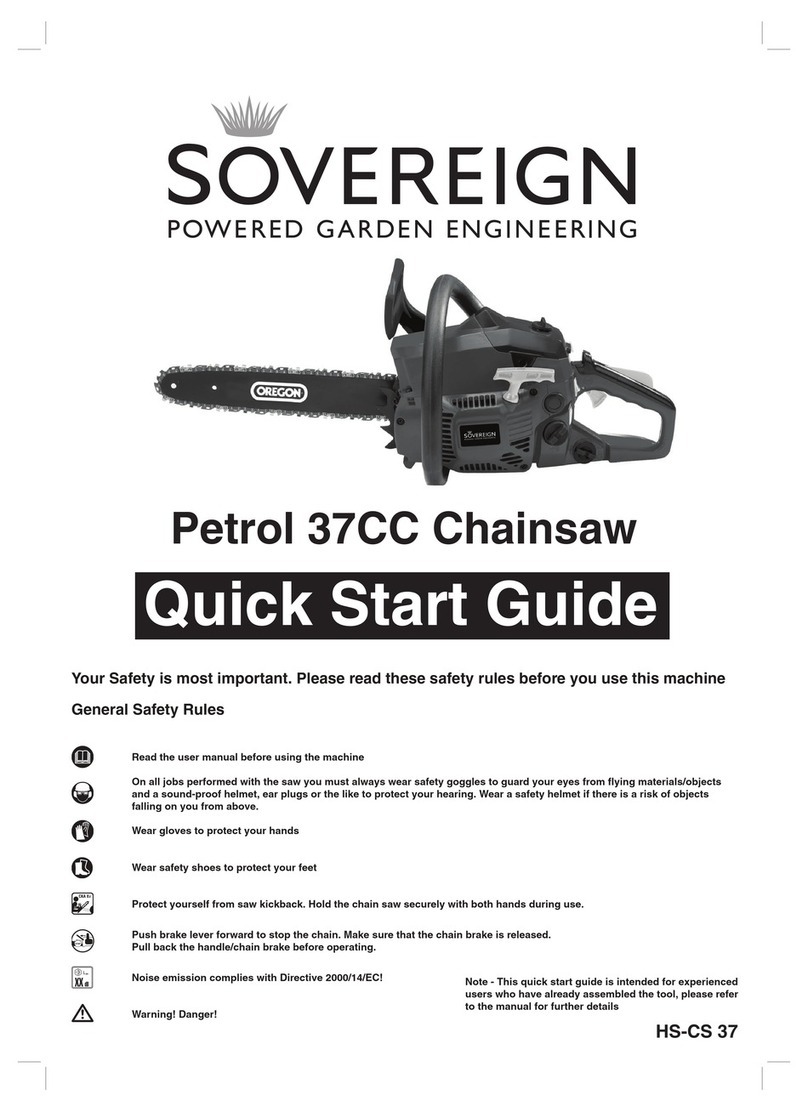
Sovereign
Sovereign HS-CS 37 User manual
